Bayou Segnette State Park, Westwego, Louisiana (New Orleans)
There’s a racetrack around here. Somewhere close. I know this because the racing began promptly at 8am this morning. That seems awfully early to me. Maybe they want to get it done before church? Probably not, but one can hope. They don’t seem to bother the little yappers next door. It’s almost 10am and we’ve yet to hear them. Maybe they only bark in the evening . . .
It’s Palm Sunday! I love church on Palm Sunday! All the joy! All the pageantry! The songs that you only get to sing once a year!
Maybe next year . . . Sigh . . .
We visited Westwego First Baptist Church this morning. The male staff was friendly, (even sitting to talk with us) but no one else. But that’s OK. I was eager to get the service started! However, their focus was more Good Friday than Palm Sunday this morning. Rats! That happens sometimes. Even at The Chapel. Makes me wonder if it’s when they don’t have a Maundy Thursday or Good Friday service?
But even the message today had nothing to do with Palm Sunday, as the Pastor let us know up front when he took the pulpit. But it was still a good message. He’s working through a series on the book of Genesis. Today’s message focused on Chapter 44, when Joseph had a special cup placed in his brother’s bag and then had the whole family arrested.
Let me begin by giving you a synopsis of Joseph – just in case there’s someone out there who doesn’t know or remember the story.
A man of God named Jacob had 12 sons. These sons were to become the 12 Tribes of Israel. Very important in both Jewish and Christian history. Jacob had a favorite son. Joseph. All his brothers knew he was a favorite and they didn’t like it at all. In fact, when Jacob laid the last straw on the camel by giving Joseph a special multicolored coat, ten of the brothers took Joseph, threw him in a well overnight and sold him to some traveling merchants the next day. They took his coat, tore it up, put animal blood on it and told Dad that Joseph was dead. (Nice, huh? How did they live with themselves?)
God had a great plan for Joseph, though.
So, the merchants ended up selling Joseph to an important guy in Egypt. Joseph had his ups and downs there – including being accused of attempted rape by his boss’s wife, being imprisoned longer than he was supposed to be (especially since the whole thing was a set up by a scorned woman), but eventually, when God’s timing was perfect, Joseph was promoted – – to second in command under Pharaoh himself! And all because God gave him the gift of interpreting dreams!
Skip a few years, there’s a long and horrible famine in Egypt. Everyone’s out of food, except the Pharaoh and that’s only because of Joseph’s dream interpretation and godly wisdom to save up for the coming famine. So everyone who wants to eat, eventually comes to Egypt to buy grain so they can survive.
Including Joseph’s brothers.
It’s been a really long time since these guys have seen each other, so they don’t recognize Joseph. But he recognizes them!
Now you’d think that because this is a Bible story about an extremely godly man, that there’d be a happy reunion and forgiveness all around, but that’s not what happened.
Joseph gives his brothers a really hard time. He can do that. He’s the “VP” of Egypt and the Pharaoh pretty much lets Joseph do whatever he wants. Joseph pretends not to know them. He has his steward put all the money they paid for their food back in their sacks. They go home. They find the money. When they start to run low on food again, they return to Egypt to buy more, bringing the first money with them with the intention of returning it, along with the money they need this time. (Honest men at heart. Their history what anger/hate can do to you when you let it.)
Joseph accuses them of being spies. Asks if they have any other relatives Yes. A father and another son. (Jacob has a new favorite since Joseph’s “death”. His name is Benjamin and he’s Joseph’s younger brother.)
When they tell Joseph this, he demands to see the brother and has one of the brothers put in prison until they return with Benjamin. The brothers beg him not to do this. But he insists.
They go home, manage with great difficulty, to convince Jacob to release Benjamin to their care. The brothers return to the palace, Simeon is released from prison, they all have a party with Joseph, get more food to take home and are preparing to return home, happy with life in general.
Here’s where today’s message picks up the story. None of Joseph’s behavior over all this has ever made sense to me. For me, that’s about to change. The Pastor is quick and adamant to point out that his words today are strictly his own thoughts, his own theories as to why this story, over the course of three chapters, is so detailed in what happens, especially as it kinda paints Joseph in an ‘ungodly’ light.
So, we begin in Chapter 44.
Apparently, Joseph has this special “divination” cup. Whether or not he actually uses it, remains a mystery, but 400 years later, God forbids it’s use via His words to Moses. We know that God has specifically given Joseph the gift of interpreting dreams, which does not involve magical cups. These divination cups were used by pagan priests or mystics – definitely not godly men. They’d pour water in them, then add oil, swirl it around and “read” what it said (sounds a lot like tea leaves to me). Joseph had one of these cups in his possession.
He has his steward hide the cup in Benjamin’s bag of grain and sends the brothers warmly on their way back home. Oh. By the way. They still don’t recognize him.
Then he has the steward chase after them claiming they stole said cup, and the steward begins his search from the oldest to the youngest. (Can you just imagine the confusion of the steward over all these wacky orders??) Anyway, the brothers are absolutely certain that he won’t find it in their possession, but of course he does, and he hauls them all back to Joseph to face severe consequences. Namely the death of Benjamin and enslavement for the others. (YIKES!)
But the stakes are changed, and only Benjamin has to stay and face consequences – permanent enslavement.
Knowing how Dad will feel about this, one of the brothers offers to take Ben’s place as a slave to Joseph. Joseph leaves the room and in private, sobs so loudly that everyone can hear him. This isn’t the first time he’s cried over all this, either.
So what’s up? Why is Joseph behaving this way? It seems as if this godly man, Joseph, is toying with his brothers. But that’s not it. If you read the three chapters that deal with this subject, you’ll find Joseph going through a myriad of emotions – freaked out, grief, anger, plotting and scheming, plus a few others and yes, some love in there.
What’s actually happening (according to this Pastor) is that Joseph is experiencing a roller coaster ride of emotions – because he’s human. He’s slipped and is letting his emotions rule his behavior as he makes decisions. Just like most of us do when emotions are involved. When the past comes back to haunt us. When we’re angry. When we’re freaked out. When the unexpected or unimaginable happens. When confronted with emotional issues, we don’t think straight. We don’t behave or speak the way we normally would.
But God can use even our bad decisions to further His will. He already knows how we will respond. And in the midst of the hurts and emotions, God has a plan.
And we know that in all things God works for the good of those who love Him, who have been called according to His purpose. Romans 8:28
We have a tendency to look at a portion of this verse and just think that everything is going to be great for everyone, but if you look at it closely, that’s not what it says.
It says that God works good, even when we mess up. It says that He’ll do that for those who love Him. For those who belong to Him. His children by faith in Jesus Christ. It says we’ve been called into that faith to serve His purpose. For His glory.
Thank You, Lord!!
This afternoon, we visited the Jean Lafitte National Historical Park and Preserve in the Park they call the Barataria Preserve. It’s a different kind of situation here for this National Park. It actually encompasses six locations spread out all over the place – up to 180 miles apart, including two in the French Quarter.
The French Quarter ones are the Visitor Center/Museum, and also a Jazz Museum. When we visited the French Quarter, we couldn’t find the Jazz one. We’ll try again at a later date.
Who’s Jean Lafitte anyway? Must be someone pretty important to Louisiana or New Orleans to have his name on six National Parks spread over 180 miles, don’t you think?
This is what I uncovered:
From the Park’s brochure – In the Battle of New Orleans, Jean Lafitte commanded a large confederation of smugglers and privateers based in Barataria Bay. Though long hounded by American authorities for smuggling slaves and goods, he joined forces with Andrew Jackson in the battle, providing men, artillery and information. Pardoned for his service, he slipped from the pages of history and lingers only in delta legend.
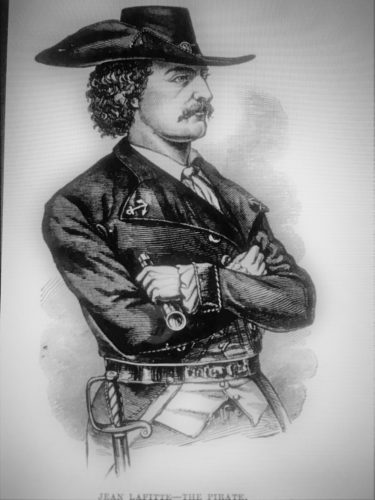
And from their website:
Quick Facts
SIGNIFICANCE: Hero of War of 1812; pirate/privateer
PLACE OF BIRTH: Most likely Haiti or France
DATE OF BIRTH: 1780s
PLACE OF DEATH: Unknown
DATE OF DEATH: Unknown
Jean Lafitte was probably born in the early 1780s in either France or the French colony of St. Domingue (now Haiti) in the Caribbean. By 1810 he was in Louisiana with his older brother Pierre. They were most likely businessmen in New Orleans or independent privateers before becoming associated with the smuggling and piracy.
In 1807 the United States outlawed trade with Great Britain and France because of the Napoleonic Wars in Europe. Merchants in New Orleans began to run out of goods to sell, including slaves. It was around this time that the Lafitte brothers engaged in smuggling and piracy. Merchants and planters were eager to buy the goods and slaves Lafitte smuggled into south Louisiana.
By 1812 Lafitte was the leader of the Baratarians with headquarters on Grand Terre, a barrier island in the Gulf of Mexico near Grand Isle. Lafitte may have had as many as 1000 people working for him, including free men of color and runaway slaves. The men working for Lafitte were called Baratarians because the waterways they used for smuggling were located in an area called Barataria (the Barataria Preserve of Jean Lafitte National Historical Park and Preserve is located in this area). Barataria’s swamps and bayous stretched south of New Orleans to the Gulf of Mexico. This area had been famous for smuggling even before privateers arrived in 1810 to use the deep water harbor of Barataria Bay.
Throughout Barataria, Lafitte built warehouses to store goods and pens to hold slaves. Merchants and planters came to Barataria for auctions, which Lafitte held outside New Orleans to avoid the law. His knowledge of the swamps helped him to make quick getaways. Several times customs officials and soldiers tried to capture Lafitte in the swamps, but they were usually captured, wounded, or killed by the Baratarians. In 1812, several Baratarians including both Pierre and Jean Lafitte were captured but escaped. In the summer of 1814, Pierre was arrested and jailed in New Orleans, but he escaped from jail under mysterious circumstances in September.
Lafitte’s image changed from pirate to patriot during the War of 1812. Britain and the United States declared war in June 1812, but until 1814, most of the fighting took place on the east coast or northern border of the United States. In September 1814, British military officials sought Lafitte’s help in their campaign to attack the U.S. from the Gulf of Mexico. Lafitte decided to warn American authorities and offered to help defend New Orleans in exchange for a pardon for his men. His warnings were not believed at first and the U.S. Army and Navy went ahead with a planned attack on Lafitte’s base at Grand Terre.
Although General Andrew Jackson, commander of the American troops, originally described Lafitte as a “hellish banditti,” he finally accepted Lafitte’s help because of the ammunition, cannoneers, and knowledge of the area Lafitte could supply. The expert cannon fire of Jackson’s troops, including Lafitte’s Baratarians, contributed to the American victories during the New Orleans campaign that culminated with the Battle of New Orleans on January 8, 1815. Most of these battles took place at or near Chalmette Plantation, now Chalmette Battlefield and part of Jean Lafitte National Historical Park and Preserve.
Thankful for their help with the American victory, in February 1815 President James Madison offered pardons to the Baratarians for any crimes committed against the United States. Many of the Bartarians settled in New Orleans or in the Barataria area and some of their descendants still live there today. Lafitte eventually returned to smuggling at Galveston Island in Spanish Texas until he was forced out by the U.S. Navy in 1820. His exact whereabouts after that are unknown. His life and death remain as mysterious as the swamps and bayous of Barataria.
And from Britannica.com:
Their information was virtually the same as the National Park’s, except for after the presidential pardon . . . .
Nevertheless, after the war the pirate chief returned to his old ways, and in 1817, with nearly 1,000 followers, he organized a commune called Campeche on the island site of the future city of Galveston, Texas, where he served briefly as governor in 1819. From this depot he continued his privateering against the Spanish, and his men were commonly acknowledged as pirates. When several of his lieutenants attacked U.S. ships in 1820, official pressure was brought to bear on the operation. As a consequence, the following year Laffite suddenly picked a crew to man his favourite vessel, The Pride, burned the town, and sailed away—apparently continuing his depredations along the coast of Spanish America (the Spanish Main) for several more years.
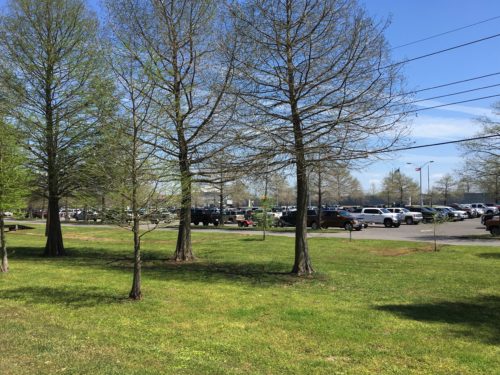
Heading out.
This parking lot is near the campground and within the Park boundaries. It’s near the boat launch.
Normally, there are a few cars and boat trailers here, but today was overflowing!!
We took the kayak with us today because we’d read several places that you could kayak in the bayou. The information is outdated. Bummer! The Ranger told us there’s no kayaking anymore because it’s too ‘congested with debris’. They didn’t say if it was the result of Katrina or just time. Regardless, there’ll be no kayaking today.
So, instead we hiked a trail. It was hot. It was sunny. There wasn’t a lot to see. But as I’ve always said, there’s always something!
Correction. After looking at the pictures we took, turns out we saw some wonderful scenery! Maybe I was just too disappointed in not being able to kayak to notice at the time. Shame on me!


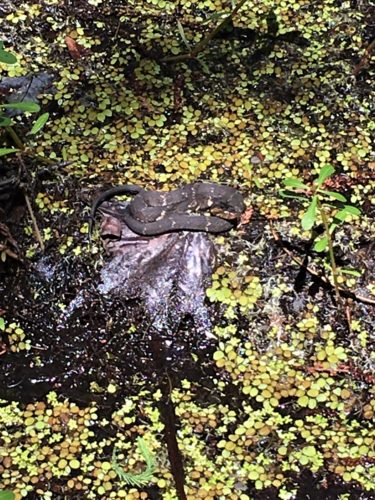
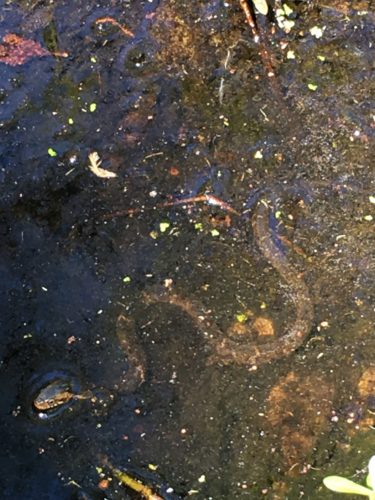
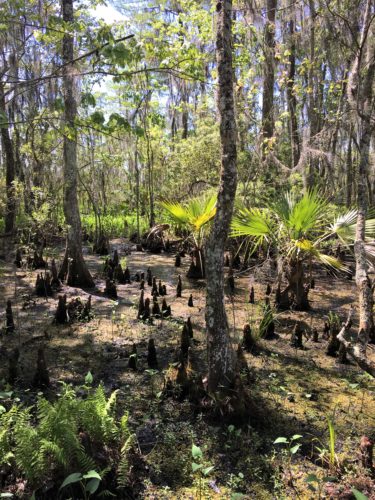
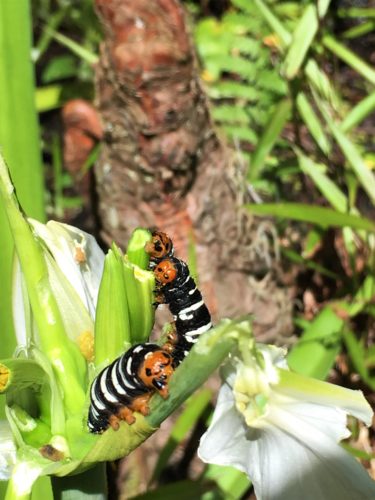
This has to be one of my favorite pictures – – ever!
A gentle breeze at the time made the video a bit blurry.
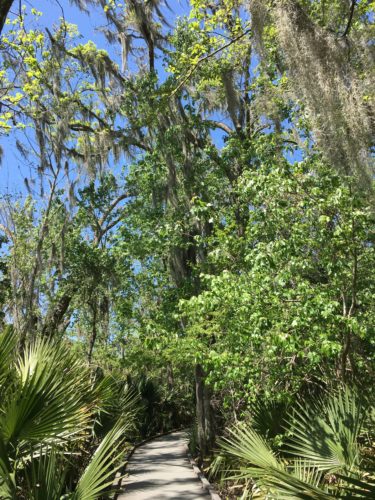
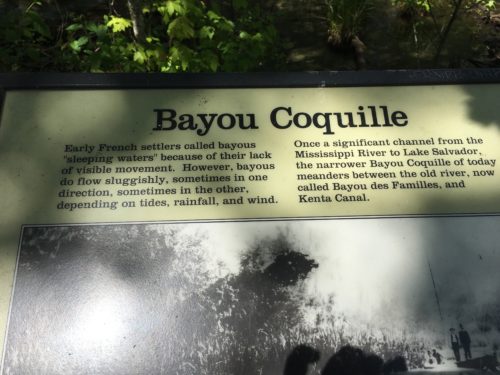
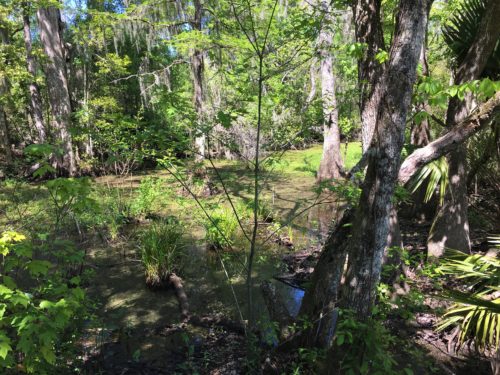
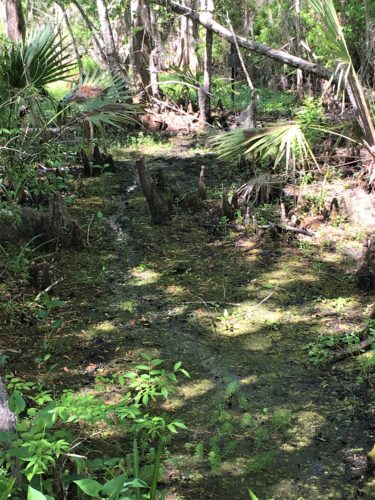
Probably a gator trail
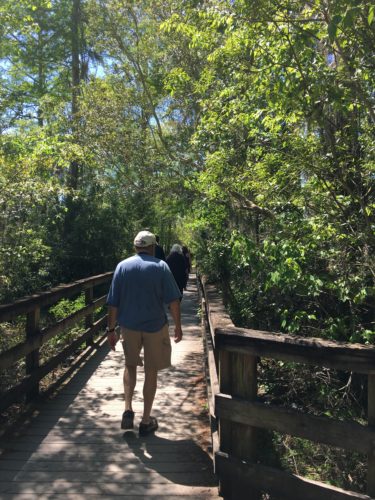
The trail was crowded today. . .

Thistle before it blooms
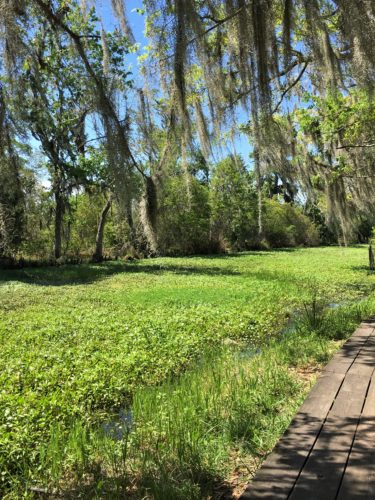
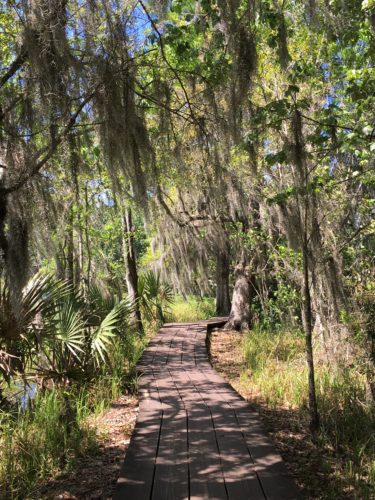
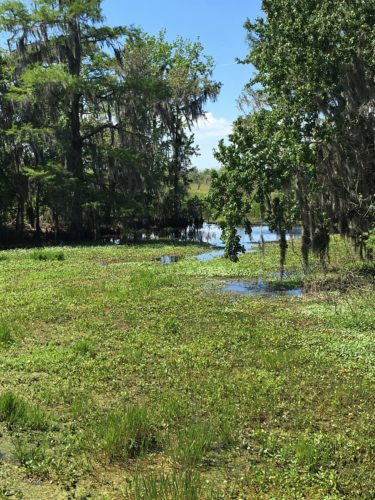
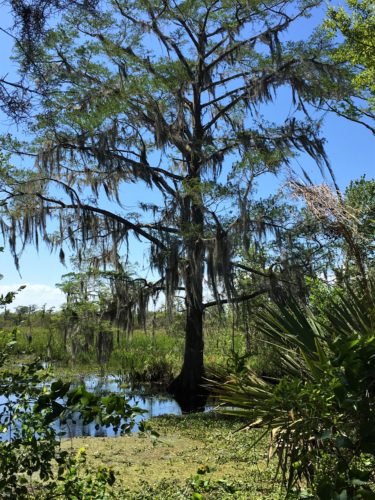
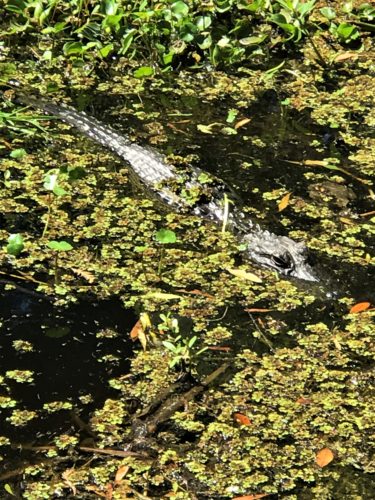
We actually saw quite a few alligators today.
And a few snakes.
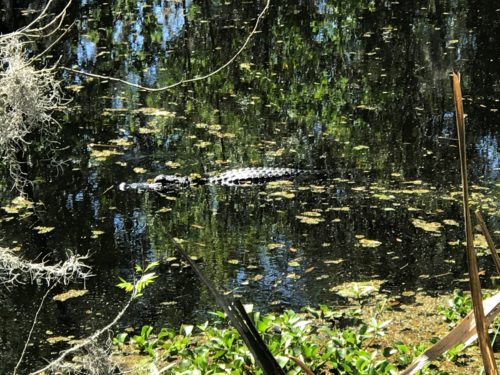
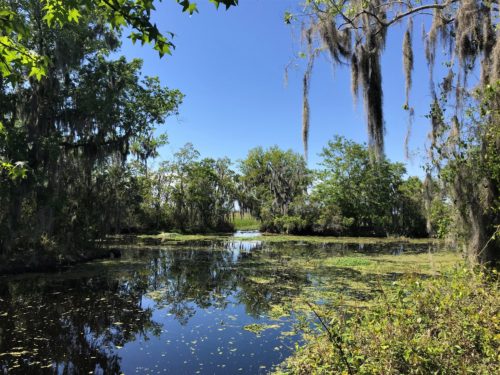
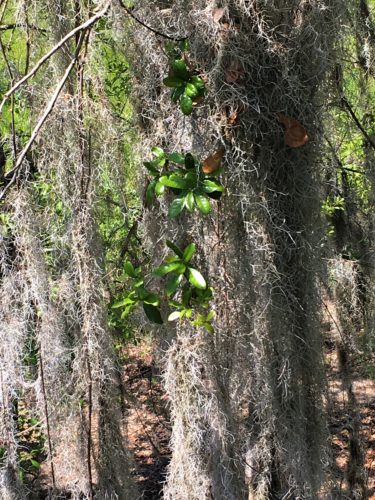
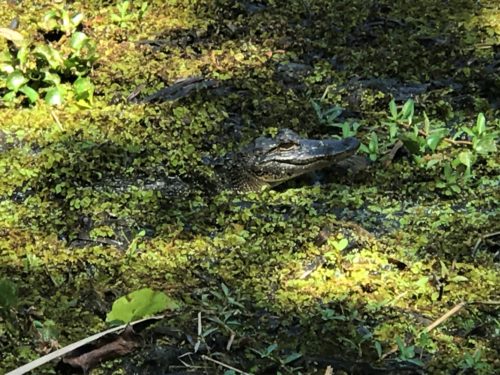
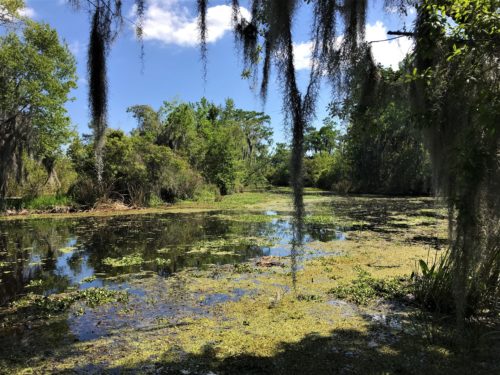
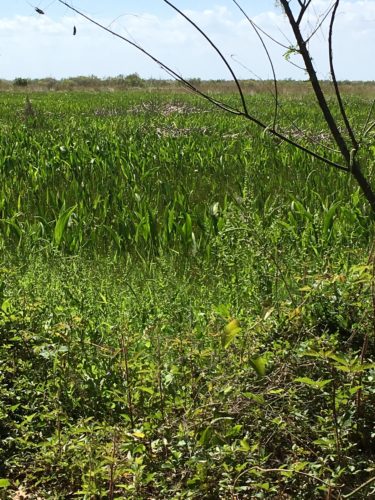
Wide open spaces!

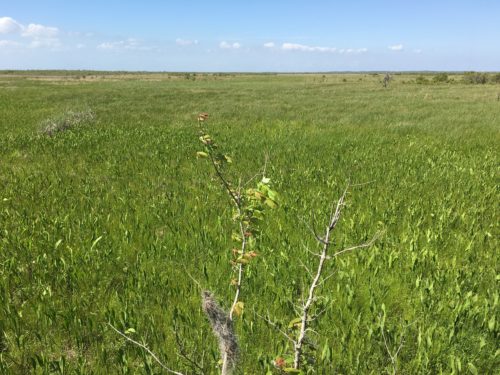

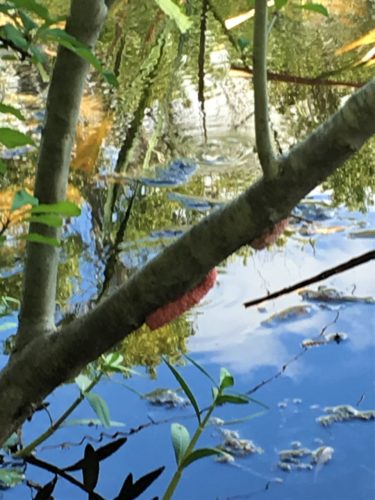
I’ve noticed this particular fungus several places in our travels down here.
No idea what it is.
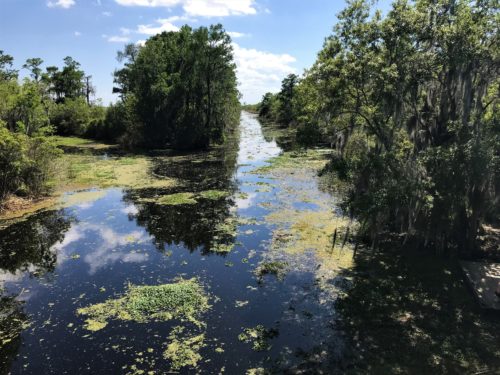
Videos of an alligator actually swimming! It was fun to watch!
As we were walking back to the Jeep, we stopped short and admired this:
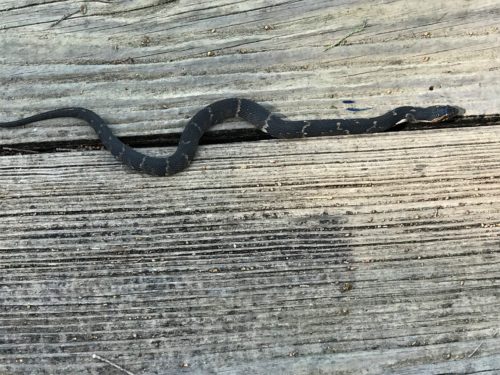
It never moved!
We gave it a wide berth and warned the ladies who were behind us to do the same.
No argument from them!
TOTAL HIKING MILES: 2.5
Year To Date: 239.5
Daily Average: 2.88
